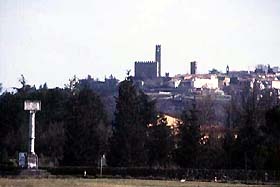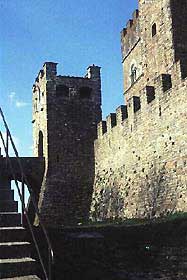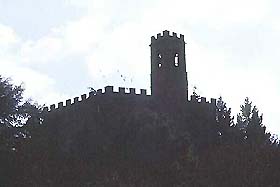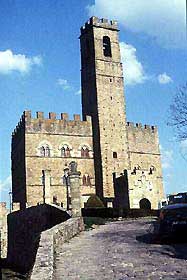Poppi Castle
|
 |
| The embattled skyline of Poppi castle. | The castle from the plain of Campaldino, site of the famous battle of 1289. |
Poppi with its magnificent castle rises on a hill, at the right of the river Arno for who comes from Florence, in the center of the Casentino valley, that from it can be entirely dominated. The castle can be reached following the SS70 Umbro-Casentinese, leaving it to the height of Ponte a Poppi, ancient 'market site', and driving up to the top of the hill where the medieval settlement still rise.
Click here to see a Map of the castle
|
The castle of Poppi it's the most important medieval monument of the whole Casentino area. Unlike all the other castles and architectures of the zone it wasn't wasted by the time or ruined by the men, having always been used as residence of the local political or administrative power, in fact it is still today seat of the Commune of Poppi. Since its origins the history of the castle was strongly tied to that of the biggest feudal family of the Casentino that made of Poppi the center of their big ownership and lived in this castle for almost four hundred years: the counts of the Guidi family.
Despite to the fact that the first written notices of the existence of the castle are dated 1191, its architecture and the vast possessions owned by the Guidi in Tuscany and Romagna at that time, lets us presuppose that the foundation was antecedent of two or three centuries, back to the period between the Longobard and French invasions of Italy.
The original nucleus of the castle is constituted by the high square tower that still our days dominates the rest of the construction and almost all the underlying valley. The today's aspect is not original, in fact in the last century the tower was partially reconstructed, principally during the restoration following the damages suffered for the fall on it of a lightning. The tower had to be taller and gifted of machicoulis (projection from the wall made of stone which has openings through which the defenders can fire upon an enemy directly below), if it is true that it was taking for example from Arnolfo di Cambio for the construction of that of 'Palazzo Vecchio' in Florence, luckily still today intact. Three-four meters of the base are currently buried, subtracting us the sight of the scarped wall of which the tower was endowed, complement to the perpendicularly defense used at that time. The scarce openings present in the masonry seem to be original. After the tower was built a walled enclosure all around, from which the other buildings of the fortification were then developed.
The complex was endowed with only two gates, the main on the side towards the valley and Ponte a Poppi with a steep ramp of access and the other one on the opposite side toward the square of the town. After the last big restructuring of the castle in 1470 was this last, with the name of 'Lion gate', to become the principal access.
 |
| The 'Munizione tower' seen by the ditch. |
The castle was widened with the construction of a rectangular block placed on the right of the tower (looking from the square). This was the primitive keep, turned respectively from the low plans toward the highest to jail, deposit and residence. Today it is united at the tower by a curtain wall, but originally the two constructions had detached, connected only by a drawbridge at the highest plan, to be independent and eventually each at defense of the other. In the hall of the residential plan of the keep was signed in 1440 the act of surrender of the last of the counts Guidi, Francesco, to the Florentine Republic.
Almost contemporarily was also begun the construction of the other wing of the castle from the opposite side of the tower. This was built only up to the foreground when the keep was finished, but it was enough for the creation of the inside courtyard that we can still admire today, rich of coats of arms in stone of the Florentine families that developed the Vicariate at the castle. On the side toward Ponte a Poppi the courtyard is closed by the Chapel. Great part of these work are attributed to the count Simone Guidi, responsible of the great first restructuring, initiated in 1274, that raised the original small fortress to the rank of feudal residence. To increase the elegance of it he opened also some windows with bifores on the fašade of the castle.
Another big intervention had been brought ahead since 1470. This interested principally the inside courtyard with the construction of the splendid staircase in stone for the access at the varied plans of the building. Was also excavated the ditch of separation between the castle and the square and on the outer walls was erected the 'Munizione Tower' at defense of the 'Lion gate'. The 'Munizione' was also endowed of a drawbridge, today disappeared. The castle was by now a splendid residential building. The works of the last century, with the remaking of big part of the battlements and the restoration of the bifores and other parts of the masonry, has given to the castle its splendid today's aspect .
| More Photos |
| View the castle Map |
| Back to Homepage |
| Back to Castles Index |

